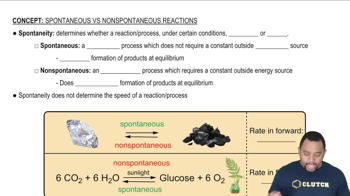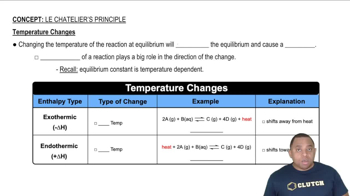Here are the essential concepts you must grasp in order to answer the question correctly.
Spontaneity of Reactions
The spontaneity of a reaction refers to whether a reaction can occur without external intervention. A reaction is spontaneous if it leads to an increase in the entropy of the universe, which is often assessed using Gibbs free energy. If the change in Gibbs free energy (ΔG) is negative, the reaction is spontaneous; if positive, it is nonspontaneous.
Recommended video:
Gibbs Free Energy
Gibbs free energy (G) is a thermodynamic potential that helps predict the direction of chemical reactions. It combines enthalpy (H) and entropy (S) into the equation ΔG = ΔH - TΔS, where T is the temperature in Kelvin. A negative ΔG indicates a spontaneous process, while a positive ΔG suggests nonspontaneity. The equilibrium temperature occurs when ΔG equals zero.
Recommended video:
Gibbs Free Energy of Reactions
Equilibrium Temperature
The equilibrium temperature is the specific temperature at which a reaction shifts from being spontaneous to nonspontaneous, or vice versa. At this temperature, the Gibbs free energy change (ΔG) is zero, indicating that the forward and reverse reactions occur at the same rate. This concept is crucial for understanding how temperature influences reaction spontaneity.
Recommended video:
Temperature and Equilibrium Shifts
 Verified step by step guidance
Verified step by step guidance

